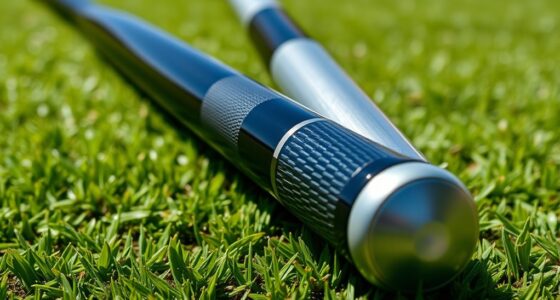To take the extra base smartly, you need to assess the play quickly—look at where the ball is, fielder positions, and your speed. Decide whether to sprint, hold, or slide based on the situation. Use proper slide techniques, like feet-first for safety or head-first to beat a tag, and stay alert for changes like misthrows. Mastering these decisions and techniques makes you a smarter, more effective baserunner. Keep learning to turn routine plays into game-changing advances.
Key Takeaways
- Assess the play quickly by observing fielder positions, ball trajectory, and throw likelihood before deciding to advance.
- Choose the appropriate slide technique—feet-first or head-first—based on the situation for safety and speed.
- Keep your body low and controlled during slides to maintain stability and avoid injuries.
- Stay alert and adaptable; modify your slide or retreat if the play changes unexpectedly or if a misthrow occurs.
- Practice decision-making and slide execution regularly to improve safety, speed, and overall base running effectiveness.

Have you ever wondered what it takes to be a smart and successful base runner? It’s not just about speed or agility; it’s about making quick, strategic decisions that keep you safe and advance your team’s chances of scoring. One of the most essential skills in your arsenal is mastering slide techniques. Knowing when and how to slide can make the difference between advancing safely or getting tagged out. But slide techniques alone aren’t enough—you need sharp decision-making skills to determine the right moments to slide, which type of slide to use, and how to execute it effectively.
Your decision-making process starts with awareness. Before you even reach the base, you need to read the play, assess the situation, and anticipate the throw. Will the ball be in the air long enough for you to take an extra base? Is the fielder in position to make a quick tag? These questions help you decide whether to sprint, hold, or slide. When you see an opportunity to take an extra base, don’t rush blindly—consider your speed, the arm strength of the defender, and the distance you’ll need to cover. Making the right call at the right moment is what separates good base runners from great ones.
Smart base running starts with reading the play, assessing the situation, and making quick, strategic decisions.
Once you’ve decided to slide, your slide technique becomes critical. There are different types of slides—feet-first, head-first, or a pop-up slide—each suited to specific situations. Feet-first slides are safer for avoiding injuries and are often used when you want to stop yourself quickly or avoid a tag. Head-first slides can help you accelerate into the base, especially when trying to beat a close tag or when you need to slide into a tight space. The key is to execute your chosen slide smoothly and efficiently. Keep your body low, slide with your hands and feet close to the ground, and aim for a controlled, quick movement to minimize the chance of missing the base or getting tagged. Additionally, understanding the Unique and Wicked Planters can inspire creative ways to visualize and improve your sliding technique by incorporating artistic elements into your training routines.
Your decision-making doesn’t stop once you’ve committed to the slide. You should always be prepared to adjust if the play changes unexpectedly. If the throw is off, you might need to scramble back or change your slide technique. Being alert and adaptable ensures you maximize your chances of a safe slide and extra base. Practice your slide techniques regularly, and always think through the scenarios you might encounter. When your decision-making is sharp and your slide techniques are polished, you’ll become a smarter, more effective base runner who consistently takes the extra base and helps your team succeed.
Frequently Asked Questions
How Can I Improve My Slide Timing for Extra Bases?
To improve your slide timing for extra bases, focus on your slide biomechanics and practice slide drills regularly. Pay attention to how you plant your lead foot and lower your body smoothly, ensuring quick and efficient slides. Incorporate specific slide drills into your training to develop muscle memory and reaction time. Consistent practice will help you time your slides better, allowing you to take extra bases with confidence and speed.
What Are Common Mistakes to Avoid When Sliding?
When sliding, avoid common mistakes like misjudging your slide technique or rushing, which can lead to injuries or missing the base. Always keep your body low and control your momentum to stay safe and effective. Focus on a smooth, deliberate slide as part of your base running strategy. Don’t forget to look for the best angle and timing—these are key to taking that extra base successfully.
How Do I Decide When to Take an Extra Base?
Imagine risking it all for that one extra base—sounds intense, right? You decide when to take an extra base by doing quick risk assessments on the fly. Look at the ball’s position, your speed, and the thrower’s arm strength. If the risk is worth the reward, go for it! Smart base running means knowing when the gamble pays off and when to play it safe, keeping you ahead of the game.
What Equipment Is Best for Safe Sliding?
When choosing equipment for safe sliding, focus on slide padding and your sliding stance. Opt for well-padded sliding shorts or pants with extra cushioning to protect your hips and thighs. Maintain a low, controlled sliding stance to minimize injury risk. Practice sliding techniques regularly so you can stay balanced and avoid dangerous falls. Proper gear and technique will help you slide safely and confidently, reducing the chance of injuries during aggressive base running.
How Do I Recover Quickly After a Slide?
After a slide, you should quickly get back on your feet by using proper slide technique—rolling onto your side and pushing up with your hands. Keep your body low to avoid injuries and stay alert for the next play. Focus on maintaining momentum and control during your base running. This helps you recover fast, stay safe, and be ready to advance or defend, making your overall game more effective.
Conclusion
Mastering smart slides keeps you safe, speeds you up, and helps you advance. By reading the game, staying alert, and using proper technique, you boost your chances of taking that extra base. Remember, quick thinking, precise movements, and confident slides turn good runners into great ones. Keep practicing, stay focused, and always play smart. With each slide, you become more skilled, more confident, and more unstoppable on the base paths.









